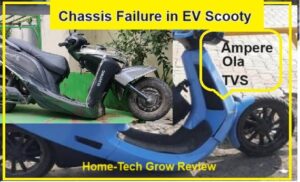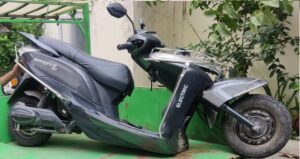Common Causes of Chassis Breaking
- Chassis breaking in electric scooters can be a serious issue, impacting both safety and vehicle integrity.
- Here are some points to consider regarding chassis breaking in electric scooters, specifically focusing on TVS and Ampere brands:
- Material Defects: The use of substandard or defective materials in manufacturing can lead to weak points in the chassis, making it prone to breaking.
- Design Flaws: Poor design can result in stress concentrations at specific points in the chassis, leading to fractures or breaks over time.
- Manufacturing Errors: Inconsistent manufacturing processes or errors can result in defects that weaken the chassis.
- Overloading: Consistently carrying loads beyond the scooter’s capacity can strain the chassis, leading to breakage.
- Impact Damage: Collisions, bumps, or falls can cause structural damage that might not be immediately apparent but can lead to failure over time.
- Corrosion: Exposure to moisture and other corrosive elements can weaken the metal components of the chassis.

Potential Solutions:
- Material Upgrades: Ensuring high-quality, durable materials are used in manufacturing.
- Design Improvements: Redesigning chassis to eliminate stress points and ensure even distribution of weight.
- Enhanced Quality Control: Implementing rigorous testing and quality checks during production.
- User Education: Educating users on the importance of adhering to load limits and handling the scooters properly.
- Regular Maintenance: Encouraging regular maintenance checks to identify and address any early signs of wear or damage.
- Corrosion Prevention: Applying protective coatings and advising proper storage to minimize exposure to corrosive elements
TVS and Ampere Specifics:
- TVS: Known for robust manufacturing standards, but issues can still arise. Regular maintenance and adhering to weight limits are essential to prevent chassis problems.
- Ampere: As a newer player in the electric scooter market, Ampere focuses on affordability, which might sometimes lead to compromises in material quality. Ensuring proper usage and routine checks are crucial.
Prevention and Maintenance Tips:
- Regular Inspections: Routinely check the chassis for signs of wear and tear, including cracks or rust.
- Weight Management: Avoid overloading the scooter beyond its recommended capacity.
- Safe Riding Practices: Drive carefully to avoid accidents that could damage the chassis.
- Environmental Protection: Keep the scooter protected from harsh weather conditions to prevent corrosion.
- Professional Maintenance: Schedule regular maintenance with authorized service centers to identify and address potential issues early.
What to Do if You Experience Chassis Issues:
- Stop Using the Scooter: If you notice any signs of chassis damage, stop using the scooter immediately to avoid accidents.
- Consult a Professional: Have the scooter inspected by a professional to assess the damage and determine the best course of action.
- Warranty and Support: Check if your scooter is still under warranty and contact the manufacturer or dealer for support and possible repair or replacement.
Conclusion:
- Chassis breaking in electric scooters is a critical issue that requires attention to safety and maintenance practices.
- By understanding the common causes and taking preventive measures, you can ensure a longer lifespan for your scooter and a safer riding experience.
- By addressing these concerns, manufacturers like TVS, Ampere, and Ola can ensure that their electric scooters are both safe and reliable for consumers.
- If you’re experiencing issues, it’s advisable to contact the respective customer service for immediate assistance and possible solutions.



